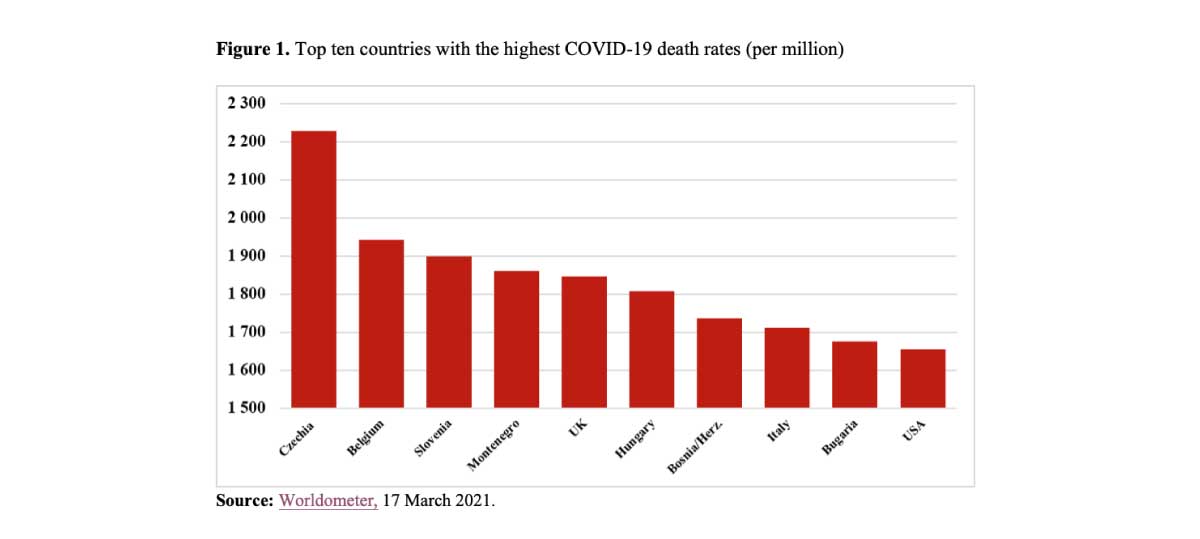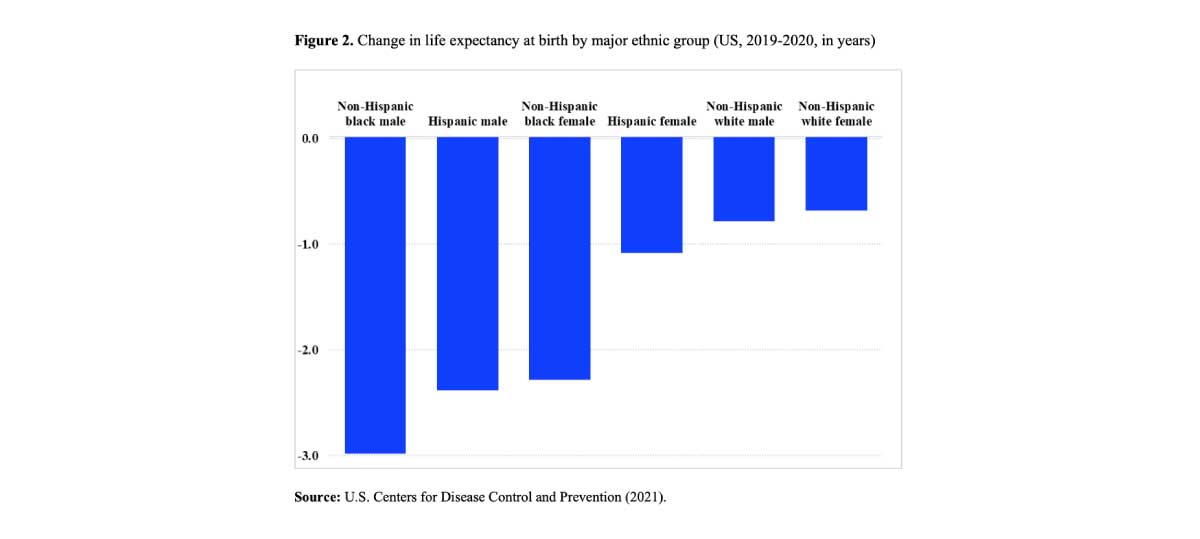COVID-19 pandemic: demographic highlights

The COVID-19 pandemic caused by the SARS-CoV-2 coronavirus has resulted in enormous consequences worldwide. Joseph Chamie highlights the pandemic’s impact on the components of population change: mortality, fertility and migration. In addition to nearly three million deaths, the pandemic has affected births and human mobility. Worrisome concerns are emerging in the pandemic’s second year.
One year after being declared a global pandemic on 11 March 2020, the effect of the SARS-CoV-2 coronavirus on world population is considerable. In addition to its far reaching social, economic and political consequences, the pandemic has greatly impacted the key components of world demographics: mortality, fertility and migration. The coronavirus continues to challenge governments worldwide, and several worrisome concerns are emerging during the second year of the pandemic.
Mortality
By mid-March 2021, the reported number of COVID-19 deaths worldwide is approaching 3 million, while around 120 million people have been infected. In both cases, these numbers are likely to be grossly underestimated.
Just five countries account for about half of all reported deaths. The U.S., with 4% of the world’s population, is in the lead position with well over half a million fatalities, representing 21% of all COVID-19 deaths. Next come Brazil, Mexico, India and the U.K. with 10%, 7%, 6%, and 5% of total deaths, respectively.
The ten countries with the highest COVID-19 death rates – all above 1,600 per million population – are all in Europe, except for the United States (Figure 1).

The diversity of COVID-19 death rates among countries is particularly noteworthy. The U.S. rate of more than 1,600 per million far exceeds the rates of Germany (887), Israel (658), Canada (593), Denmark (413), Japan (69), and Australia (35). Men tend to have higher COVID-19 case fatality rates than women, but in some cases, such as India, Nepal and Vietnam, the reverse is true.
The risk of severe illness and death from COVID-19 increases with age, with the elderly being at the highest risk: about 80% of the victims in the U.S. are aged 65 years and older.
Provisional data for several hard-hit countries indicate that life expectancy at birth has declined as a result of the pandemic. In the United States, for the first half of 2020, life expectancy at birth declined by 1.2 years for males and 0.9 years for females.
Importantly, significant differences in life expectancy decline are also observed across major U.S. socio-economic groups (Figure 2). The largest decline in life expectancy at birth was 3 years for non-Hispanic black males and the smallest was 0.7 years for non-Hispanic white females.

Fertility
The coronavirus pandemic has influenced fertility in many countries, but in very different ways. Some developing countries, including India, Indonesia, the Philippines and Uganda, report the beginnings of a baby boom, believed to be largely due to women being unable to access modern contraceptives.
In contrast, many other countries, including China, Italy, Germany, France, Spain, the United Kingdom and the United States, are facing declines in births pointing to a baby bust. In China, it is estimated that fewer babies were born in 2020 than in any year since 1961, when China experienced mass starvation. In the United States, around 300,000 fewer births are expected in 2021.
Migration
As a result of travel bans, restrictions and lockdowns, migration across international borders came to a virtual standstill in early 2020. In just a matter of several months, the world experienced the biggest and most rapid decline in global human mobility in modern times.
Many migrant workers were unable to travel in search of work and many returned to their home countries. Due to border closures, some migrant workers were stranded abroad and unable to return to their homes.
As well as curtailing the movements of migrants, business travelers and tourists, border closing significantly limited the entry and processing of refugees and asylum seekers. Despite the restrictions, however, many men, women and children continued to cross borders illegally.
The pandemic has also influenced internal migration (World Economic Forum 2020). In many countries, the coronavirus has caused a reverse migration from cities to less populated places and rural areas. High coronavirus infection rates closely linked to high-density urban living, combined with prolonged urban lockdowns, are causing people to rethink their residential choices. In various developing countries, including India, Kenya, Peru and South Africa, many urban dwellers are returning to their rural villages.
Concerns
Among the worrisome concerns about the pandemic in the near term is the emergence of more contagious and possibly more lethal variants of the coronavirus. Variants of the SARS-CoV-2 coronavirus first detected in China have already been reported in Brazil, South Africa, the United Kingdom and the United States.
Another serious concern is the formidable challenge of ensuring global availability and access to COVID-19 vaccines, especially among low-income nations. While about 225 million doses of vaccines had been administered by the end of February, most of them were in high-income countries.
Somewhat ironically, there is also a concern about refusal to take the COVID-19 vaccine. Based on more than a dozen country surveys, it is estimated that approximately a fifth of people across the world would refuse to be vaccinated. High levels of vaccine refusal would threaten the goal of achieving herd immunity. This also raises the contentious issue of what activities might be prohibited for unvaccinated people (Wouters et al. 2021).
Numerous aspects of the coronavirus remain unclear, unresolved and puzzling. One thing, however, appears certain for the second year of the pandemic: many more people will have an Appointment in Samarra.¹
References
U.S. Centers for Disease Control and Prevention. (2021) “Provisional Life Expectancy Estimates for January through June, 2020”. Vital Statistics Rapid Release, February
World Economic Forum. (2020) “How COVID-19 will impact our cities in the long term”. 20 November
Wouters O.J., et al. (2021) “Challenges in ensuring global access to COVID-19 vaccines: production, affordability, allocation, and deployment”. The Lancet, 12 February
Note
¹ Those who have not read John O’Hara’s 1934 novel may like to know that an ancient Mesopotamian tale appears as an epigraph for the novel: A merchant in Baghdad sends his servant to the marketplace for provisions. Soon afterwards, the servant comes home white and trembling and tells him that in the marketplace, he was jostled by a woman, whom he recognized as Death, who made a threatening gesture. Borrowing the merchant’s horse, he flees at great speed to Samarra, a distance of about 75 miles (125 km), where he believes Death will not find him. The merchant then goes to the marketplace and finds Death, and asks why she made the threatening gesture to his servant. She replies, “That was not a threatening gesture, it was only a start of surprise. I was astonished to see him in Baghdad, for I have an appointment with him tonight in Samarra.” (Source: Wikipedia)